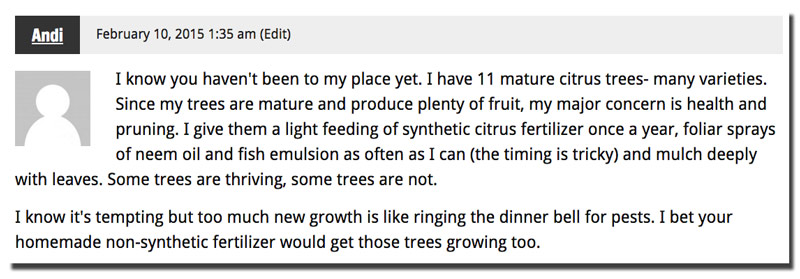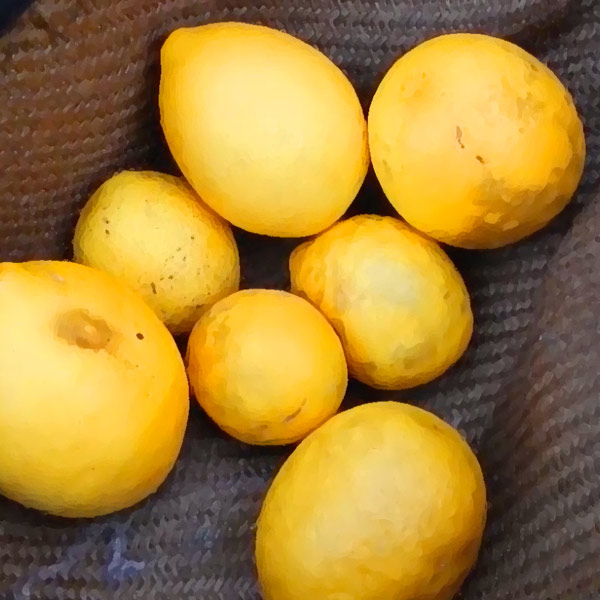Are you growing Key limequats in your yard? Key Limequats are a pretty little citrus fruit with good flavor, originating from a cross between Key limes and kumquats. The trees are short and moderately cold-hardy, unlike the very cold sensitive Key lime.
A few years before I quit recommending citrus (for the reasons, keep reading), I planted a Key limequat in my yard. This year it gave me a nice hat-full of fruit. Here’s my latest video where you can see the little tree and its fruit:
Key limequat rinds are sweet while their centers are quite sour. After you eat one, it’s very much like you took a bite of sour Key lime pie.
I’m going to try to talk my wife into making some Key limequat pie with the fruits I just harvested so we can see how it compares to true Key lime pie. The taste isn’t exactly the same, as key limequats tend more towards the sour without that tangy bitter undertone that gives Key limes their unique flavor profile.
Growing Key Limequats
Key limequats are a non-demanding citrus that require little more than a small corner of your yard and some water to get established.
I cover my citrus trees on freezing nights with thrift store sheets and blankets, as you can see in this video. The Key limequat always comes through fine, unlike some of my oranges which usually suffer some frost damage despite the blankets.
Hoe away weeds around the base of your Key limequat and it will reward you with faster growth. I mulched mine, though that’s not the recommended practice for citrus.
Key limequat trees can take some shade, can grow in pots and they’ll also do great planted up against the south wall of a house if you’re in a colder area.
If you hit your Key limequat and other citrus trees with chemical fertilizers, they’ll grow like crazy. Here’s a schedule for fertilizing citrus. That said, organic options are probably better. Though I fertilized all my citrus this year on schedule with 10-10-10 and they grew like crazy, they also suffered a bit from bug attacks – as predicted by my friend Andi on the citrus fertilizing post linked above:

As Andi remarked, increasing growth via chemical means leaves the new growth more susceptible to insect and disease attack. That doesn’t mean it’s always wrong, just that I don’t recommend it for folks not willing to keep a close eye on their trees.
And that ties into the main danger with growing Key limequats: citrus greening.
Key Limequats and Citrus Greening
The biggest problem you’ll face in growing key limequats is the greening virus. Greening kills all citrus and it’s spread throughout my home state of Florida. If you’re in a location where citrus greening isn’t a problem, great. Otherwise, the life of any citrus tree you plant is likely to be cut short. It’s basically incurable, though some strides have been made in recent years with heat treatments and nutritional supplementation.
I recently wrote a song on citrus greening. Here, watch it:
Doesn’t that bring a tear to your eye?
I hate what citrus greening has done to the citrus across my state and to the farmers that rely on citrus for their livelihoods. I generally blame monoculture farming for this disease, yet I understand why citrus is grown the way it is for the sake of management and harvesting. Some researchers feel the same way:
“One of the reasons greening has hit the citrus industry so hard is that growers depend on just a few varieties to produce their crop, because they’re most likely to withstand Florida weather and still make fruit consumers want to buy, Grosser said.
“For the course of the last several 100 years, we’ve been eliminating the genetic diversity in the wild, so citrus has kind of gone to a monoculture where there are just a handful of varieties grown,” Grosser said.”
You could also potentially lay the blame on free trade, which has brought in a lot of plant material and pests from other nations (not to mention the fact that it’s gutted the US economy and filled up our hardware stores with Chinese junk).

So – should you plant a Key limequat in the face of greening? That’s up to you. It may live a long productive life… or it may need to be pulled out in four years. I have read that kumquats are more resistant to greening than some citrus, as are Key Limes. This may simply be because they’re less attractive to the psyllid that spreads greening, rather than any intrinsic resistance to the disease itself.
Thus far, my citrus trees are doing fine. We’ll have to wait and see – and I’m enjoying eating my Key limequats in the interim.


8 comments
David, have you heard of companion planting citrus with guavas (pineapple or strawberry or the like) as a way to repel citrus psyllid? May have heard it here or some other perma-web site, but was wondering if you’ve any clue of the efficacy? Thanks.
Yes – see here: http://www.thesurvivalgardener.com/prevent-citrus-greening-hopefully-citrus-tree-guild/
One person claimed that only tropical guavas repel; however, I can’t find any further data to verify that the other guava species/relatives don’t do the same.
Thank you for the link. My citrus trees really look like crap this year- never ever give citrus trees a hard pruning and then don’t prune at all the next year, especially with mature trees. Now we’re going to have to start all over with the pruning, and we’ll probably lose at least one tree. I am super envious of your limequat! I have a beautiful old kumquat tree that makes kumquats by the thousands but no one in my family is able to eat more than a couple.
Where can you get the plants in North Fl?
I’ve seen them at Home Depot. Another place to ask is Blue Star Nursery in Hawthorn, if you’re close to there.
I picked up a plant last year at Home Depot on sale and it looked like crap and was reduced to 15$ because of how bad it looked. I am going to try and take cuttings this year but its leafed back out completely and looks good. I put it up against a brick wall facing south and am going to attempt to keep it pruned up and espaliered somewhat. I have it next to a meiwa kumquat and those are my only two small producing citrus as they can be crazy to pick. My goal is to keep them in the 6-7 foot range, grow them in together somewhat as they are only 5 feet apart and keep them separated from my other citrus.
I am devastated. My limequat made it through the first freeze, wrapped up so very, very well. And then the plant-sitter didn’t protect it while i was out of town for the next freeze. Now it is gone and I see no way to replace it with all the restrictions both getting it into my state, and even into my county, from someone who is growing it still in my state. It is THE ESSENTIAL climate tolerant tree for all the many things we use limes for, producing like crazy and without fail – until it died from severe cold. HOW DO I MAKE ONE FOR MYSELF????
You would have to cross a key lime and a kumquat. Much easier to take a road trip and buy one. I’m really sorry.
Comments are closed.